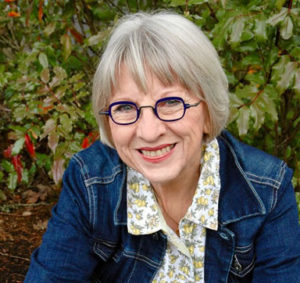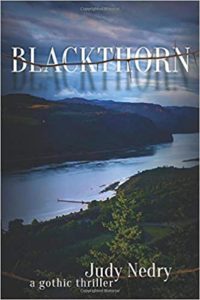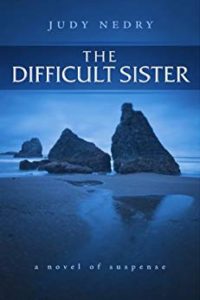 by Judy Nedry
by Judy Nedry
When I started writing my first gothic novel, I wasn’t thinking of vampires. or anything close to that. Rather than vampires and 1990s teens running around in black garb and white makeup, my idea of a gothic was the more traditional.
My new gothic thriller, Blackthorn, is a mystery story told in the traditional gothic style first popularized by the Bronte sisters: Jane Eyre, Wuthering Heights. During the Romantic movement and into Victorian times, gothics were extremely popular with their gloomy, decaying settings, damsels in distress, heroes, and romance. Charles Dickens’s A Christmas Carol is a gothic. Edgar Allen Poe supplied his own versions of the genre.
Gothics enjoyed a resurgence in the 1930s with such authors as Daphne DuMaurier, who wrote two of my all-time favorites—Rebecca and Jamaica Inn—both of which featured rather helpless women who became strong through adversity, one in a billionaire’s mansion, the other in a creepy inn on the Cornish moors. Another story you may know that is told in the gothic style is Stephen King’s The Shining.
In these three novels and others like them, an outsider arrives—often a young woman—who doesn’t know what’s going on. Creepy and sometimes awful things happen. There are bumps in the night and then some! When I first read Rebecca in my early twenties, I knew I had a gothic in me.
My first three novels—An Unholy Alliance, The Difficult Sister, and The Man Who Wasn’t There—are part of the Emma Golden mystery series. Emma is a snarky has-been wine writer who got tripped up by alcoholism. Now that her head is clear from a few years of abstinence, she seems to have acquired a talent for solving murders. During most of her adventures, her friend Melody, who owns a nice B&B out in Oregon wine country, is her sidekick, constantly goading her into action and providing comic backup. A lot of humor pops up in the series. They’re almost cozies—with a decided edge. Blackthorn is darker.
Blackthorn is a murder mystery, the tagline for which is “Jamaica Inn meets The Shining”. Writers, in fact all creative people, are copycats. We don’t plagiarize, but we do get ideas from other works. In Blackthorn, I drew inspiration both from King’s The Shining and DuMaurier’s Jamaica Inn.
If you break down The Shining, it’s basically the story of a drunk doing a geographic and thinking things will improve. Hired to be the winter caretaker, the main character drags his wife and young son to an old lodge cut off from civilization by winter snow. The geographic does not solve his problems. He drinks, hallucinates, and becomes a danger to himself and his family. More goes on, of course. You really should read it.
In Jamaica Inn, a young woman leaves her home after the death of her mother to live with her aunt at a lonely inn on the Cornish moors. She finds in her aunt a troubled soul, abused by a husband who drinks, hallucinates, and is a danger to himself and others. But more goes on here. We find evil secrets and murder, and two men who offer her a way out.
 In Blackthorn, I make direct reference to Jamaica Inn as a nod to my inspiration, Daphne DuMaurier. There’s a big old house, in this case, the dilapidated inn on the Washington bank of the Columbia River that was Sage Blackthorn’s childhood home. The mysterious death of her brother happens. Sage does a geographic when she takes leave from her job as a travel editor in New York to return to the Blackthorn Inn. And like Mary in Jamaica Inn or that star-crossed family in The Shining, Sage finds herself unable to leave Blackthorn long after she knows she should.
In Blackthorn, I make direct reference to Jamaica Inn as a nod to my inspiration, Daphne DuMaurier. There’s a big old house, in this case, the dilapidated inn on the Washington bank of the Columbia River that was Sage Blackthorn’s childhood home. The mysterious death of her brother happens. Sage does a geographic when she takes leave from her job as a travel editor in New York to return to the Blackthorn Inn. And like Mary in Jamaica Inn or that star-crossed family in The Shining, Sage finds herself unable to leave Blackthorn long after she knows she should.
Gothics are not around much anymore, at least not the gothics I once enjoyed so regularly. But inspired by these authors, plus another British author, Victoria Holt, who became popular in the 1960s, I felt determined to write one.
I found Blackthorn a hard book to write in a lot of ways, but I felt compelled to do it. The book offers a mystery, of course. But it also is the story of a young woman’s spiral into alcoholism and the consequences of that spiral. It gets ugly, as most stories about addicts do.
 In the Emma series, the heroine has made it to the other side of her disease and is able to manage it. Blackthorn finds Sage is in the middle of her battle with addiction, and this situation creates a lot of problems for her. As in The Shining, Sage sees things, or thinks she sees. Are they real? Is she paranoid? Is she being set up? Like many people in her situation, she gets into the sort of trouble normal people don’t.
In the Emma series, the heroine has made it to the other side of her disease and is able to manage it. Blackthorn finds Sage is in the middle of her battle with addiction, and this situation creates a lot of problems for her. As in The Shining, Sage sees things, or thinks she sees. Are they real? Is she paranoid? Is she being set up? Like many people in her situation, she gets into the sort of trouble normal people don’t.
As in traditional gothics, we also have a story about place—in this case, the Columbia River Gorge, a designated National Scenic Area. Ever since my childhood, I’ve seen the Gorge as filled with mystery and intrigue. When I was a little girl, we drove to Portland twice a year to visit my grandparents. Once we moved from the desert into the tall firs and steep cliffs along the Gorge, I’d make a game of counting the waterfalls on the Oregon side. And when we neared the city of The Dalles, in the years before The Dalles Dam was built, I’d watch the Indians standing on rocks in the rapids, spearing and netting salmon during the sacred salmon runs.
I’ve studied how the Gorge was formed from great floods following the Ice Age, floods that carved those cliffs on the Oregon side, along with the south-slanting slopes on the Washington side. To me, the Gorge is sacred ground. It’s a land of stories where gods of the indigenous people fought so violently over a woman that they were turned into mountains—Hood, Adams, and St. Helens (the woman). People see Bigfoot in the forests surrounding the Gorge. Mystery and history and story and even a touch of otherworldliness exists in this place, and always has. What a perfect setting for a gothic novel!
Sage is a part of the Gorge and the Northwest story. Even when she lives in New York, the region is still in the girl. She even mentions, early in the book, that she returns to her West Coast way of talking shortly after she returns to the Northwest. Sage isn’t a New Yorker; she’s one of us.
Place always figures as a character in my books, whether it’s the vineyards and wineries of the Willamette Valley, the back roads outside Bandon, or the Columbia River Gorge. Place determines the types of people readers encounter. Donald the Pothead, the mysterious man in the woods, Misty and Janice and Betty and the rest are not the folks you’d meet in mainstream Portland, Oregon. They wouldn’t fit in there. It’s a different vibe. Each place I write about has its own vibe, and that’s very important to the story.
So, when I start to write a story, I think of place first. What is the mood there? Is it dark and mysterious, as in Blackthorn? Or menacing and suffocating, as in The Difficult Sister? In my wine-country novels, people tend to be murdered at celebrations where lots of people who may not be paying attention. And from these beginnings, the story becomes grounded.
Blackthorn takes place on the banks of the Columbia River, in an area that has intrigued me all my life. But for years the story just wouldn’t gel. And it wasn’t a gothic, it felt like something else. Twenty years ago, I tried to write it. I wasn’t ready. I hadn’t practiced fiction writing enough. I didn’t have as many skills.
Three novels later, things came to me, bits and pieces from my own past that somehow started to fit together. Rodeos. I knew about rodeos. I knew about the Gorge. Young, naïve girl gets her journalism degree and moves to New York City. Yes, I’d even had a brush with that, but I didn’t stay. Sage did. Most of my life was before cell phones. Cell phones complicate gothic novels because they make it too easy to call for help, so we didn’t want cell phones. The novel is set in 1985, so cell phones are not an issue. And I do have experience with a brain that is not my friend, but rather one scary neighborhood.
What anyone who writes fiction knows is that we’re not always in charge of our stories. We’re inspired by other stories we’ve learned along the way. And there are, as someone once famously said, “the known unknowns and the unknown knowns.” We must practice. We must be patient. And one day, perhaps, those unknown knowns will become known. We will write the novel we always aspired to write. Or we will write something else.
Judy Nedry is an independent author, blogger, and drama critic. She is author of the Emma Golden Mystery Series set in Oregon wine country, and Blackthorn, a gothic thriller. She resides in Portland, Oregon.


